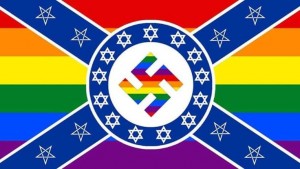The swastika, from Sanskrit svastika, meaning “good fortune” was, as the translation suggests, not originally a negative symbol, and the Nazis should not be allowed to destroy the symbol for all time. We need to re-appropriate it, or in the case of the Jews, appropriate it.
The swastika, in its various forms, exists in Buddhism, Hinduism, Jainism, is found in art throughout the world, including in Roman mosaics. To view a symbol, which has been used by many cultures, for thousands of years, as negative, because of the actions of a group that have existed for less than a century, and to restrict the usage of it, even by the groups who have a long history tied to the symbol, is a total violation of freedom of expression, and quite literally enforces the tyrannical values of the Nazis.
So it is reasonable to push to have the symbol re-appropriated by those who have been using it. It even makes sense for other groups to appropriate it. This is not totally unheard of. Groups who have been oppressed will sometimes appropriate the symbol of their oppression. Perhaps the most often seen example is the Christian cross. While it literally symbolizes the Roman execution of Jesus, it has clearly taken on a very different meaning.
In the same way, the Jewish people should appropriate the swastika, and turn it from a symbol of hate, back into a symbol of good fortune, or the many other meanings that the symbol takes in various cultures. So long as we continue to automatically equate the symbol to hatred, anyone who uses it will be able to immediately instill in us that thought. If we flood the world with its other uses, then the Nazi meaning becomes dulled and weak.
 The same is true with many other symbols. That is one of the reasons why one of my favourite images is the “nazi, gay pride, battle flag of North Virginia” image, that’s seen on the left. Unfortunately Facebook has deemed it too offensive to allow on their site, even though they allow outright hate speech in other cases. And while refusing to facilitate content distribution is not censorship, biased execution of the TOS, along with a failure to identify the meaning behind images like the flag on the left, make it difficult to properly express the importance of these ideas.
The same is true with many other symbols. That is one of the reasons why one of my favourite images is the “nazi, gay pride, battle flag of North Virginia” image, that’s seen on the left. Unfortunately Facebook has deemed it too offensive to allow on their site, even though they allow outright hate speech in other cases. And while refusing to facilitate content distribution is not censorship, biased execution of the TOS, along with a failure to identify the meaning behind images like the flag on the left, make it difficult to properly express the importance of these ideas.
There is another side to the attacks on swastikas, of all sorts and it is very disturbing. Swastikas have now “become a symbol of hate.” Apparently this needs to be true for everyone and everywhere. What this attack on the symbol is saying is that every person around the world, regardless of his or her heritage, must view the symbol based on the way it was defined by a tyrannical western nation. This demand is tantamount to imperialism. Imagine if instead of the swastika, Nazis chose to use the Star of David. Would that mean that every Jew would from them on have to recognize the symbol as a symbol of hate? It seems only that because the symbol is mostly foreign to the west that everyone is okay with the west imposing its view of the symbol on the world.
Admittedly this has been tried before, and hasn’t succeeded yet. KA designs tried to do this. It backfired. That is not surprising though. A single company is not going to make a difference. It has to be a cultural movement. Luckily there are companies available that produce swastika themed clothing, mainly from Asia. I recently picked up a t-shirt which had a very nice design on it.
As you can see, it is not just a swastika, which should help with any confusion. However, it is likely still going to get attention, so anyone wearing one is going to have to deal with it. Maybe we can start by pushing for wearing more of these designs within Asian-American populations who already recognize the symbol as being something of religious significance rather than a symbol of hate.
And here’s another t-shirt which looks even better. I will definitely be getting this one next time. Honestly, I wish I had these shirts when I was going for my yoga teacher certification. And remember, don’t let anyone tell you that this symbol means hate. Do not let one fascist regime’s legacy decide how we view a symbol that is thousands of years old.



